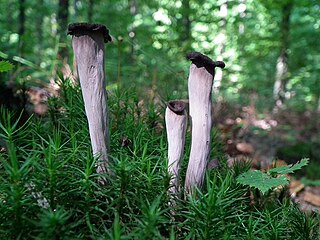Related Research Articles

Mycology is the branch of biology concerned with the study of fungi, including their genetic and biochemical properties, their taxonomy and their use to humans, including as a source for tinder, traditional medicine, food, and entheogens, as well as their dangers, such as toxicity or infection.

The Russulales are an order of the Agaricomycetes,. According to the Dictionary of the Fungi, the order consists of 12 families, 80 genera, and 1767 species. According to Species Fungorum, the order contains 13 families, 117 genera, and 3,060 species.

Secotioid fungi are an intermediate growth form between mushroom-like hymenomycetes and closed bag-shaped gasteromycetes, where an evolutionary process of gasteromycetation has started but not run to completion. Secotioid fungi may or may not have opening caps, but in any case they often lack the vertical geotropic orientation of the hymenophore needed to allow the spores to be dispersed by wind, and the basidiospores are not forcibly discharged or otherwise prevented from being dispersed —note—some mycologists do not consider a species to be secotioid unless it has lost ballistospory.

The Boletaceae are a family of mushroom-forming fungi, primarily characterised by small pores on the spore-bearing hymenial surface, instead of gills as are found in most agarics. Nearly as widely distributed as the agarics, the family is renowned for hosting some prime edible species highly sought after by mushroom hunters worldwide, such as the cep or king bolete . A number of rare or threatened species are also present in the family, that have become the focus of increasing conservation concerns. As a whole, the typical members of the family are commonly known as boletes.

Eurotiomycetes is a large class of ascomycetes with cleistothecial ascocarps within the subphylum Pezizomycotina, currently containing around 3810 species according to the Catalogue of Life. It is the third largest lichenized class, with more than 1200 lichen species that are mostly bitunicate in the formation of asci. It contains most of the fungi previously known morphologically as "Plectomycetes".

Craterellus is a genus of generally edible fungi similar to the closely related chanterelles, with some new species recently moved from the latter to the former. Both groups lack true gills on the underside of their caps, though they often have gill-like wrinkles and ridges.

Calostoma is a genus of 29 species of gasteroid fungi in the suborder Sclerodermatineae. Like other gasteroid fungi, Calostoma do not have the spore discharge mechanism associated with typical gilled fungi (ballistospory), and instead have enclosed spore-bearing structures. Resembling round puffballs with raised, brightly colored spore openings (ostioles), elevated on a thick, gelatinous stalks, species have been collected in regions of deciduous, temperate, tropical or subtropical forests. Their distribution includes eastern North America, Central America, Asia, and Australasia. The common name given to some species, "prettymouth", alludes to the brightly colored raised openings (ostioles) that may somewhat resemble lips. Other common names include "hotlips" and "puffball in aspic".

The Stereocaulaceae are a family of lichen-forming fungi in the order Lecanorales. It contains five genera. Species of this family are widely distributed in temperate boreal and austral regions.
Setomelanomma is a genus of fungi in the family Phaeosphaeriaceae. This is a monotypic genus, containing the single species Setomelanomma holmiiM. Morelet (1980)
Zopfia is a genus of fungi in the family Zopfiaceae. The widespread genus contained 5 species, until another species was accepted.
Cesatiella is a genus of fungi in the family Hyponectriaceae.

Polyozellus is a fungal genus in the family Thelephoraceae, a grouping of mushrooms known collectively as the leathery earthfans. Previously considered a monotypic genus, it now contains the Polyozellus multiplex species complex. The genus name is derived from the Greek poly meaning many, and oz, meaning branch. It is commonly known as the blue chanterelle, the clustered blue chanterelle, or, in Alaska, the black chanterelle. The distinctive fruit body of this species comprises blue- to purple-colored clusters of vase- or spoon-shaped caps with veiny wrinkles on the undersurface that run down the length of the stem.
Therrya is a genus of fungi within the Rhytismataceae family.
Arthotheliopsis is a genus of fungi in the family Gomphillaceae. It has 5 species. The genus was circumscribed by Finnish lichenologist Edvard August Vainio in 1896, with A. hymenocarpoides assigned as the type species.
The Vialaeaceae are a family of fungi in the Ascomycota and class Sordariomycetes. In 2018, it was placed in the order Amphisphaeriales.
Klasterskya is a genus of fungi in the family Ophiostomataceae.

Clavaria is a genus of fungi in the family Clavariaceae. Species of Clavaria produce basidiocarps that are either cylindrical to club-shaped or branched and coral-like. They are often grouped with similar-looking species from other genera, when they are collectively known as the clavarioid fungi. All Clavaria species are terrestrial and most are believed to be saprotrophic. In Europe, they are typical of old, mossy, unimproved grassland. In North America and elsewhere, they are more commonly found in woodlands.

Setulipes was a proposed genus of fungi in the family Marasmiaceae. This group of mushrooms, described by the Czech mycologist Vladimír Antonín in 1987, has a widespread distribution in north temperate areas, and would contain about 25 species.

Megalospora is a genus of lichen-forming fungi in the family Megalosporaceae.
References
- ↑ Chary, C.M.; Ramarao, P. (1974), "Subbaromyces aquatica, a new ascomycete from India", Hydrobiologia , 44 (4): 475–479, doi:10.1007/BF00036311
- ↑ Lumbsch TH, Huhndorf SM (December 2007). "Outline of Ascomycota – 2007". Myconet. Chicago, USA: The Field Museum, Department of Botany. 13: 1–58.
- ↑ "Species Fungorum - Search Page - Subbaromyces". www.speciesfungorum.org. Retrieved 16 July 2023.
- ↑ Hesseltine, C.W. (1953), "Study of Trickling Filter Fungi", Bulletin of the Torrey Botanical Club, 80 (6): 507–514, doi:10.2307/2481965, JSTOR 2481965 page 511